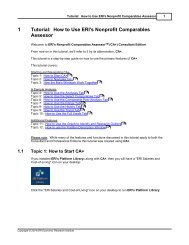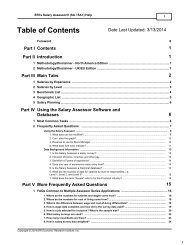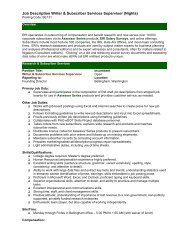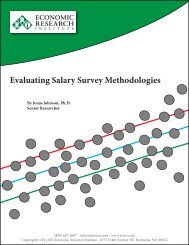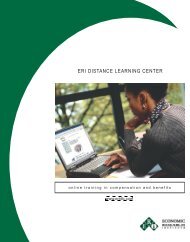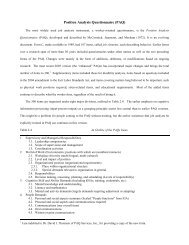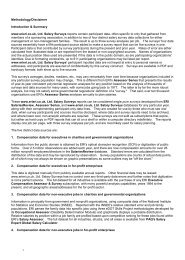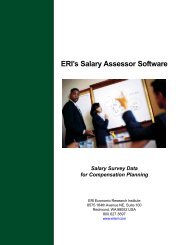FLSA Overtime Methodology - ERI Economic Research Institute
FLSA Overtime Methodology - ERI Economic Research Institute
FLSA Overtime Methodology - ERI Economic Research Institute
You also want an ePaper? Increase the reach of your titles
YUMPU automatically turns print PDFs into web optimized ePapers that Google loves.
<strong>Methodology</strong><br />
Logic and Program Flow for<br />
<strong>FLSA</strong> <strong>Overtime</strong> Module of the Occupational Assessor,<br />
also known as PAQ's enhanced Dictionary of Occupational Titles ® (eDOT)<br />
and<br />
PAQ's online scored PAQ f , Position Analysis Questionnaire (<strong>FLSA</strong> version)<br />
as found at www.paq.com<br />
Per Rules and Regulations<br />
PART 541--DEFINES AND DELIMITS THE EXEMPTIONS FOR EXECUTIVE,<br />
ADMINISTRATIVE, PROFESSIONAL, COMPUTER AND OUTSIDE SALES EMPLOYEES<br />
[Federal Register: April 23, 2004] (Volume 69, Number 79)<br />
Introduction – <strong>Overtime</strong> Protection<br />
The Federal Government has a unique way of looking at positions to determine if they should receive<br />
overtime pay. Most Americans think of jobs in terms of whether they are paid on an hourly or a salaried<br />
basis. In this regard, hourly workers are "on the clock" and must either record their actual hours worked<br />
each week or punch in and out utilizing a time clock; such hourly workers are generally paid “overtime”<br />
which is calculated as time and one-half straight time for any hours worked in excess of 40 hours in their<br />
work week (this may vary as dictated by state laws). Salaried workers, on the other hand, are paid a flat<br />
rate for a work period (weekly, bi-weekly, monthly, etc.) regardless of the actual number of hours worked.<br />
Despite this misconception, the Wage-Hour Division of the US Department of Labor does not use the<br />
“salaried” definition in determining overtime treatment. Rather, overtime treatment is determined based on<br />
an analysis of ”nature of duties”, as well as an earnings test (generally $455/week), to arrive at one of two<br />
classifications: exempt or nonexempt. These classifications do not apply to job families (e.g., clerk)<br />
because each position is unique in the duties required and warrants its own classification based on these<br />
duties.<br />
The Fair Labor Standards Act of 1932, now amended, requires all positions to be paid overtime for all<br />
hours actually worked over 40 in a week (again, this may vary by state regulations), UNLESS those jobs<br />
meet specific detailed tests that will qualify them as EXEMPT from that law. As of August 23, 2004 these<br />
tests have changed. The Federal Register forecasted (or estimated) that 6.7 million jobs (out of 137<br />
million), or 5% of all jobs, gained new overtime protections as of August 23, 2004. For the most part, these<br />
jobs will have changed status because of the “nature of duties” tests.<br />
Job Analysis and the <strong>FLSA</strong><br />
The August 2004 tests require the identification of a position's “primary duty”. For a position to be “exempt”<br />
under the <strong>FLSA</strong>, it must pass all 3 of the following tests (although some exceptions are dictated):<br />
1. Salary Level Test (minimum of $455 per week)<br />
2. Salary Basis Test (method of payment)<br />
3. Duties Test<br />
Generally it is recommended that organizations document positions via a position description including a<br />
brief outline of the position's primary duty as well as details about the position's top four to five primary<br />
tasks. There are arguments to not write or store job descriptions, but if a set of defensive records is to<br />
exist (in order to mitigate or eliminate penalties and interest with evidence of good-faith attempts at <strong>FLSA</strong><br />
compliance), documentation appears to be needed.<br />
Many job analyses questions are needed to address the new changes: required education (advanced<br />
knowledge “customarily” acquired by a prolonged course of specialized intellectual instruction), number of<br />
employees supervised, outside sales, creativity, innovation, judgment, exercise of discretion, etc. In short,<br />
compliance with this Act might be greatly enhanced by using eDOT to create a brief position description,<br />
1
eginning with an action verb and a set of updated selected characteristics of occupations (SCOs) or work<br />
measures reflecting “customary” (which we define as industry norms) measures for like jobs. Knowledge<br />
of typical SCO measures (derived from the over 100,000 eDOT Skills Project and PAQ subject matter<br />
expert field job analyses) should make updating position descriptions for these assessments quicker and<br />
easier.<br />
The new <strong>FLSA</strong> regulations utilize not only the construct of the Dictionary of Occupational Titles (DOT) and<br />
the enhanced Dictionary of Occupational Titles (eDOT), but also the language. Subpart H, 541.701, for<br />
example, states: “The phrase 'customarily and regularly' means a frequency that must be greater than<br />
occasional but which, of course, may be less than constant."<br />
In the mid 1990s, the US abandoned the DOT in favor of O*NET. However, this definition or measurement<br />
of “customarily” is not part of O*NET, thus, there is an obvious need for continued use of the DOT. For this<br />
methodology, eDOT/PAQ utilize the DOT's “Occasionally” measure (up to 1/3 the time) for evidence of<br />
existence of a trait and “Frequently” (1/3 to 2/3 of the time) for “customary duties,” as are required by the<br />
<strong>FLSA</strong> regulations. As a result, according to the eDOT methodology, customarily means a frequency<br />
greater than 1/3 of the time.<br />
In addition to these measurement issues, the work measure databases of O*NET are currently populated<br />
solely by analyses done by job incumbents. While the eDOT Skills Project has some incumbent-supplied<br />
data via web responses to 3 rotating questions obtained from 99 work characteristic measures, the<br />
majority of input is from trained job analysts and does not use employees' input as a final judgment in the<br />
measurement scale ratings. This is particularly significant for overtime analyses, where the use of<br />
incumbent decisions for exemption determination puts an organization at high risk for litigation. Many<br />
incumbents want to be exempt as a status measure, while others may wish higher earnings and welcome<br />
a nonexempt designation when these overtime funds could be saved. In most cases, practice finds job<br />
incumbents tend to rate their positions' responsibility, authority, and discretion higher than would trained<br />
job analysts.<br />
<strong>Overtime</strong> audits and litigation could quickly put millions of employer dollars at risk. Employees are not held<br />
accountable for compliance; it is the employer who defends and pays. It is the employer who makes the<br />
exempt/nonexempt determination. Job analysis and exemption determination are not matters for untrained<br />
analysts or those who have no knowledge of “customary” measures, industry norms or job analyses<br />
definitions.<br />
Summary<br />
Determinations of positions' exempt status are not easily made. They require knowledge of what the<br />
“primary duty” of a position is, the educational levels required (for the “learned” exemption), and<br />
determinations of such measures as “independent judgment,” “exercise of discretion,” and other work<br />
characteristics. In the end, a decision must be made up or down, “exempt” or “nonexempt”.<br />
We will discuss exemption determination step by step. Neither this discussion, the <strong>FLSA</strong> <strong>Overtime</strong> module<br />
of the enhanced Dictionary of Occupational Titles, or PAQ online scoring should be relied upon as an<br />
official reference for understanding and implementing the changes to the <strong>FLSA</strong> regulations. The US<br />
Department of Labor (DOL) is the authority on 29 CFR 541. It can be accessed via the DOL's FairPay<br />
Web site at www.dol.gov/fairpay.<br />
Step 1<br />
Exemption analyses begin by assuming a nonexempt classification. Among the exempt classifications<br />
there exist 5 categories: Executive, Administrative, Professional, Computer Employee and Outside Sales,<br />
along with preamble definitions of blue collar/manual labor and certain predefined “first call” and other jobs<br />
that are, by definition, nonexempt. In all, there are 6 divisions (5 exempt and 1 nonexempt) with special<br />
treatment of certain professions (teachers, creative or learned professionals, teachers or legal or medical<br />
professionals), industries and geographic areas.<br />
The initial task is to assign a position to one of the 5 exempt categories. (Note: Positions may be exempt<br />
2
in more than one category.) Underlying these categorizations is Sec. 541.2 stating, “Job titles are<br />
insufficient” for establishing exemption:<br />
A job title alone is insufficient to establish the exempt status of an employee. The exempt or<br />
nonexempt status of any particular employee must be determined on the basis of whether the<br />
employee's salary and duties meet the requirements of the Regulations.<br />
However, this does not appear in these new regulations to preclude establishing nonexempt status by job<br />
title. Any reader of the Act comes across hundreds of examples in the text that specifically state that<br />
certain jobs are nonexempt regardless of any other input. For example, new section 541.3(b) states that<br />
“the exemptions do not apply to police officers, fire fighters, paramedics, etc.”<br />
The methodology described herein solves this issue by assuming that all positions are nonexempt from<br />
the <strong>FLSA</strong> unless proven to be exempt. eDOT and PAQ scoring utilize the PAQf (complete form) job<br />
analysis input sheet, which may be an extract of the complete PAQc (complete form) questionnaire. There<br />
are no extraneous questions; all must be addressed including the determination of the primary duty,<br />
closest eDOT job match (for an assessment of “customary” measures) and determination of the skills<br />
applied (initiated with a skill verb). Also requiring input are “comment” fields where analysts record<br />
examples that justify their ratings.<br />
A word on analysts' comments: The designers of eDOT have, on average, 30 years of Human Resources<br />
experience, including great appreciation of the Solicitor General's office and <strong>FLSA</strong> compliance audits.<br />
PAQ has been supplying <strong>FLSA</strong> predictions in its Job Evaluation Reports since 1974. All attest to the most<br />
common challenge facing an employer in an audit, the propensity for analysts, who often make hundreds<br />
of these analyses a year, to forget why a certain determination was made. Logged comments as to<br />
observations can ”save the day” when an audit is forthcoming.<br />
Analysts' comments, eDOT customary industry norm predictions, and the appropriate documentation are<br />
the foundation for defensible compliance.<br />
Step 2<br />
The second task is to define the geographic area and industry in which the position exists (as variances<br />
are allowed by state/territory and industry).<br />
Examples include:<br />
· American Samoa (where the $455 per week threshold is $380)<br />
· The motion picture industry (where the base rate is $695 per week and the "requirement that the<br />
employee be paid 'on a salary basis' does not apply.") (541.709)<br />
Alaska, California, Colorado, Connecticut, Hawaii, Illinois, Kentucky, New Jersey, North Dakota, Oregon,<br />
Pennsylvania, Washington, West Virginia, and Wisconsin have their own regulations that may be more<br />
strict than the Federal Regulations. Additionally, a host of industries have some special treatment under<br />
the Federal Rules.<br />
In order to properly utilize eDOT and an online scored PAQ analysis for exemption determinations, both<br />
Industry and Geographic Area must be specified. eDOT subscribers who use the default “All Industry” and<br />
“US National” definitions may see this message:<br />
Please change the US City Area and NAICS Industry in the Data that Affect Career Assessments<br />
box at the bottom of the screen.<br />
Again, these data points are not extraneous to the <strong>FLSA</strong> analyses.<br />
Step 3<br />
Step 3 consists of two of the three tests: compensation level and manner in which paid. Most exemption<br />
categories have a default minimum salary of $455/week, however, certain categories do not. Both a<br />
3
“salaried” (method of payment) and “amount” test must be met to go forward. The latter requires<br />
individuals in certain categories be paid on a non-hourly basis. For example, if a Registered Nurse is paid<br />
hourly, it typically assures that this otherwise exempt position must be treated as a nonexempt. Contrarily,<br />
specific exemptions exist for those in the motion picture industry (as previously discussed), computer<br />
employees compensated on an hourly basis at a rate not less than $27.63 per hour, etc.<br />
A “Highly Compensated Employee” is one that receives total compensation of equal to or greater than<br />
$100,000 (base salary plus bonuses but not the value of benefits). The employee must “customarily and<br />
regularly” perform any one or more of the exempt duties or responsibilities of an executive, administrative<br />
or professional employee (primary duties).<br />
Step 4<br />
As described, there exist 5 categories of exemption: Executive, Administrative, Professional, Computer<br />
Employee and Outside Sales. For PAQ/eDOT predictions, Professional is divided into Learned, Creative,<br />
Teacher, Law and Medical sub-categories. Each of the categories has its own ambiguities, various job<br />
analysis measure criteria (education, independent judgment, exercise discretion, etc. that relate to<br />
PAQ/eDOT job analyses measures) and methodology. Determinations include defined names of skills<br />
(gerund/verbs that define the category fit) and certain prenamed job types (families or sub-families) that<br />
have special treatment under the regulations.<br />
For most jobs, assignment to a category and determination of exempt status is simple and straightforward.<br />
The economic discussions regarding the new Regulations state that 6.7 million American workers had<br />
their status “strengthened” as of August 23, 2004. It is these workers' jobs, representing 5% of all<br />
employed positions in America, where “grey areas” exist. Back pay, penalties, interest and litigation<br />
shadow these “grey area” jobs.<br />
PAQ/eDOT exemption determinations computations start with the Regulation's Preamble, which lists<br />
occupations by title where the exemption regulations do not apply. Specifically listed are ”first responders”<br />
such as: ambulance worker, correctional officer, deputy sheriff, detective, emergency medical technician,<br />
fire fighter, hazardous materials worker, highway patrol officer, investigator, paramedic, park ranger,<br />
parole officer, plumber, police officer, probation officer, rescue worker, and state trooper.<br />
Other workers who do not qualify for exemption are called “blue-collar'' workers and described as an<br />
employee performing ''work involving repetitive operations with their hands, physical skill and energy''.<br />
Examples of this category include: carpenter, construction worker, craftsman, electrician, inspector, iron<br />
worker, laborer, longshoreman, maintenance mechanic, manual laborer, mechanic, operating engineer,<br />
operator, plumber, and production-line jobs.<br />
In addition to blue collar nonexemptions, the following skill verbs are defined as nonexempt (skill verbs or<br />
gerunds):<br />
Apprehends<br />
Conducts<br />
Controls<br />
Detains<br />
Detects<br />
Extinguishes<br />
Fights<br />
Fingerprints<br />
Handles<br />
Inspects<br />
Interviews<br />
Interrogates<br />
Investigates<br />
Performs<br />
Prepares<br />
4
Prevents<br />
Pursues<br />
Repeats<br />
Rescues<br />
Restrains<br />
Works<br />
In contrast to the blue collar nonexemptions, the Regulations list the following as exempt by definition<br />
(also later test categories):<br />
Archeologist<br />
Architect<br />
Computer Programmer<br />
Medical Doctor<br />
The Regulations then describe the tests for Executive, Administrative, Professional, Computer Employee<br />
and Outside Sales exemptions. As mentioned, the first three of these have a $100,000 and above<br />
automatic exemption.<br />
Tests for Executive Employees:<br />
The primary duty is management of the enterprise or of a “customarily“ recognized department or<br />
subdivision with permanent status (in which employed). “Manages” is a key skill verb, although other verbs<br />
can give evidence (“directs,” “controls,” etc.).<br />
Other key questions are:<br />
How often does the position customarily and regularly direct the work of at least two or<br />
more other employees (or their equivalent)?<br />
Are this job incumbent's suggestions given particular weight relating to hires, fires,<br />
advancement, promotion or any other change of status of other employees?<br />
Again certain examples are given:<br />
Nonexempt by definition includes:<br />
Assistant Supervisor<br />
Relief Supervisor<br />
Working Supervisor<br />
Nonexempt skills defined include (skill verbs or gerunds):<br />
Handles<br />
Performs<br />
Repeats<br />
Works<br />
Exempt by definition includes:<br />
Assistant Manager<br />
Benefits Manager<br />
Business Owner<br />
Labor Relations Manager<br />
Pensions Manager<br />
Personnel Manager<br />
5
Retail Assistant Manager<br />
Trainee<br />
Exempt skills defined include (skill verbs or gerunds):<br />
Adjusts<br />
Appraises<br />
Determines<br />
Disciplines<br />
Handles<br />
Maintains<br />
Monitors<br />
Provides<br />
Selects<br />
Trains<br />
Apportions<br />
Controls<br />
Directs<br />
Employs<br />
Interviews<br />
Manages<br />
Plans<br />
Recommends<br />
Sets<br />
Tests for Administrative Employees:<br />
The Primary Duty is the performance of office or non-manual work directly related to the management or<br />
general business operations of the employer or the employer's customers. Also, the exercise of discretion<br />
and independent judgment must be shown, as it must be an individual “whose primary duty includes the<br />
exercise of discretion and independent judgment with respect to matters of significance.”<br />
Nonexempt by definition includes:<br />
Building Specialist<br />
Comparison Shopper<br />
Dietitian<br />
Examiner<br />
Grader<br />
Inspector<br />
Lunchroom Manager<br />
Personnel Clerk<br />
Safety Specialist<br />
Secretary<br />
Clerk<br />
Construction Specialist<br />
Environmental Specialist<br />
Fire Prevention Specialist<br />
Health Specialist<br />
Investigator<br />
Messenger<br />
Psychologist<br />
Sanitation Specialist<br />
Soils Specialist<br />
Nonexempt skills defined include (skill verbs or gerunds):<br />
Carries<br />
Inspects<br />
Performs<br />
Records<br />
Screens<br />
Services<br />
Grades<br />
Operates<br />
Prepares<br />
Repeats<br />
Sells<br />
Tabulates<br />
Exempt skills defined include (skill verbs or gerunds):<br />
Administers<br />
Arbitrates<br />
Audits<br />
Budgets<br />
Collects<br />
Compares<br />
Designs<br />
Deviates<br />
Establishes<br />
Analyzes<br />
Assists<br />
Binds<br />
Carries<br />
Commits<br />
Consults<br />
Determines<br />
Disputes<br />
Evaluates<br />
6
Exercises<br />
Formulates<br />
Implements<br />
Interviews<br />
Investigates<br />
Maintains<br />
Markets<br />
Negotiates<br />
Plans<br />
Provides<br />
Recommends<br />
Resolves<br />
Runs<br />
Taxes<br />
Waives<br />
Finances<br />
Handles<br />
Insures<br />
Interprets<br />
Judges<br />
Makes<br />
Measures<br />
Performs<br />
Promotes<br />
Purchases<br />
Represents<br />
Reviews<br />
Studies<br />
Tests<br />
Tests for Professional Employees:<br />
Learned - Professional<br />
The Primary duty includes the performance of work requiring advanced knowledge, in a field of science or<br />
learning “customarily” acquired by prolonged course of specialized intellection instruction. The duty test is<br />
threefold: work requires advanced knowledge, knowledge must be in science or learning, and<br />
“customarily” acquired by a prolonged course of specialized intellectual instruction. This prolonged course<br />
is restricted to professions where advanced training is a standard prerequisite for entrance into the<br />
profession.<br />
Examples of professions include: law, medicine, theology, accounting, actuarial computation, engineering,<br />
architecture, teaching, various types of physical, chemical and biological sciences, pharmacy and other<br />
similar occupations.<br />
Creative - Professional<br />
This exemption category requires that the primary duty must be the performance of work requiring<br />
invention, imagination, originality or talent in a recognized field of artistic or creative endeavor.<br />
Nonexempt by definition include:<br />
Animator<br />
Cartoon Artist<br />
Journalist<br />
Retoucher<br />
Reporter<br />
Nonexempt skills defined include (skill verbs or gerunds):<br />
Performs<br />
Exempt by definition include:<br />
Actor<br />
Composer<br />
Conductor<br />
Creative Cartoonist<br />
Essayist<br />
Graphic Artist<br />
Inventor<br />
Musician<br />
7
Novelist<br />
Painter<br />
Screenplay Writer<br />
Short-Story Writer<br />
Soloist<br />
Writer<br />
Exempt skills defined include (skill verbs or gerunds):<br />
Acts<br />
Analyzes<br />
Comments<br />
Conducts<br />
Interprets<br />
Interviews<br />
Investigates<br />
Performs<br />
Writes<br />
Teacher - Professional<br />
This exemption category requires the primary duty of: teaches tutors, instructs or lectures in the activity of<br />
imparting knowledge. It also requires the job incumbent to be employed and engaged in this activity as a<br />
teacher in an educational establishment by which the employee is employed. A four-year college<br />
education or equivalent is required.<br />
Exempt by definition includes:<br />
Academic Advisor<br />
Aircraft Flight Instructor<br />
Automobile Driving Teacher<br />
Coach<br />
Home <strong>Economic</strong>s Teacher<br />
Instructor<br />
Gifted or Disabled Teacher<br />
Kindergarten Teacher<br />
Moderator<br />
Nursery School Teacher<br />
Teacher<br />
Vocal or Instrumental Music Instructor<br />
Exempt skills defined include (skill verbs or gerunds):<br />
Advises<br />
Coaches<br />
Instructs<br />
Lectures<br />
Moderates<br />
Teaches<br />
Tutors<br />
Law or Medicine - Professional<br />
This exemption category is a learned professional category where “employed in a bona fide professional<br />
capacity” includes holders of a valid license or certificate permitting the practice of law or medicine or<br />
those in medicine in an intern or resident program.<br />
Exempt by definition includes:<br />
8
Attorney<br />
Counsel<br />
Dentist<br />
Doctor of Dental Medicine<br />
Doctor of Optometry<br />
Doctor of Osteopathy<br />
General Practitioner<br />
Intern<br />
Lawyer<br />
Medical Doctor<br />
Optometrist<br />
Podiatrist<br />
Osteopathic Physician<br />
Physician<br />
Specialist<br />
Tests for Computer Employees:<br />
The new Regulations add a new category of exemption, including job families of computer systems<br />
analysts, programmers, operating systems software engineers, etc. Any of three duty definitions avail a<br />
position of exemption: 1) application of systems analysis techniques and procedures, including consulting;<br />
2) design, development, documentation, analysis, creation, testing or modification of computer systems or<br />
programs; or 3) design, documentation, testing, creation or modification of programs related to operating<br />
systems. “Because job titles vary widely and change quickly in the computer industry, job titles are not<br />
determinative.” (541.400)<br />
Nonexempt by definition includes:<br />
Computer Manufacturing Laborer<br />
Computer Repairer<br />
Trainee<br />
Nonexempt skills defined include (skill verbs or gerunds):<br />
Manufactures<br />
Repairs<br />
Uses<br />
Exempt by definition includes:<br />
Computer Programmer<br />
Systems Analyst<br />
Exempt skills defined include (skill verbs or gerunds):<br />
Analyzes<br />
Applies<br />
Creates<br />
Consults<br />
Designs<br />
Developments<br />
Documents<br />
Modifies<br />
Programs<br />
Tests<br />
9
Tests for Outside Sales Employees:<br />
The Regulations contain an old category (without a test for time after 8/23/04). It includes those whose<br />
primary duty is making sales, obtaining orders or contracts for services, for the use of facilities (for which<br />
consideration is paid) outside the customary and regular place of business.<br />
Nonexempt by definition includes:<br />
Delivery Driver<br />
Driver<br />
Route Driver<br />
Nonexempt skills defined include (skill verbs or gerunds):<br />
Arranges<br />
Delivers<br />
Promotes<br />
Exempt by definition includes:<br />
Manufacturers Representative<br />
Outside Salesperson<br />
Exempt skills defined include (skill verbs or gerunds):<br />
Consigns<br />
Obtains<br />
Sells<br />
The <strong>FLSA</strong> used to require that salespeople spend less than 20% of their time on non-sales work. The new<br />
<strong>FLSA</strong> regulations eliminate this 20% threshold, as it was difficult to calculate and courts ignored it when<br />
making decisions regarding sales employees' exempt status.<br />
Note: The information above has been taken from 29 CFR Part 541 found at www.dol.gov/FairPay.<br />
Exceptions<br />
Through the years, a series of industries and occupations have gained special treatment that affect<br />
overtime treatment. The new Act specifically gives new rights to American Samoa and the Motion Picture<br />
industry. Other long-standing exemptions to the Fair Labor Standards Act include:<br />
By Industry<br />
Air Carriers<br />
Amusement Parks Seasonal<br />
Commodities Bulk Petroleum Distribution<br />
Employers subject to the Interstate Commerce Act<br />
Farms, Including Tobacco<br />
Fishing and Operations on Aquatic Products Vessels<br />
Forestry or Logging Operations – less than nine employees<br />
Motion Picture Theaters<br />
Motor Carriers<br />
Newspapers - small<br />
Railroads<br />
Telephone Organizations – small<br />
10
By Specific Jobs<br />
Caretakers to Infirmed<br />
Casual Babysitters<br />
Companions to Elderly<br />
Delivery Employees on Approved Trip Rate Plans<br />
Domestic Service Workers Residing in Their Employer's Home<br />
Farm Workers<br />
Fishermen<br />
Seamen<br />
Switchboard Operators<br />
Taxicab operators<br />
By Job within an Industry<br />
Broadcasting Stations Announcers, News Editors and Chief Engineers<br />
Commissioned Workers of Retail Auto, Truck, Trailer, Farm Implements, Boat or Aircraft<br />
Sales<br />
Mechanics in Auto, Truck or Farm Implement Retail Firm<br />
Parts-Clerks in Auto, Truck or Farm Implement Retail Firm<br />
Ministerial Within a Religious Organization<br />
Sales Workers in Auto, Truck or Farm Implement Retail Firms<br />
Highly Compensated<br />
Inputted Compensation<br />
An employee with total annual compensation of at least $100,000 is deemed exempt if the<br />
employee customarily and regularly performs any one or more of the exempt duties or<br />
responsibilities of an executive, administrative or professional employee.<br />
Various other exceptions exist. For computer employees the compensation requirement<br />
may be met by compensation on an hourly basis at a rate of not less than $27.63 (Sec<br />
541.600(d)). In the case of medical occupations, an exception exists except the<br />
exception from the salary or fee requirement does not apply to pharmacists, nurses,<br />
therapists, technologists, sanitarians, dietitians, social workers, psychologists,<br />
psychometrists, or other professions which service the medical profession. (541.600(e)).<br />
In the case of academic administrative employees, the compensation requirement also<br />
may be met by compensation on a salary basis at a rate at least equal to the entrance<br />
salary for teachers in the educational establishment by which the employee is employed<br />
(Sec 541.600(c)). eDOT defines these variances by the SOC code of the selected eDOT<br />
position (>150000 and < 151082, >=291060 and < 291070, and >=251000 and < 254000<br />
respectively). The ability to enter one's own threshold salary also exists, as the latter<br />
exceptions (rate at least equal to the entrance salary for teachers in the educational<br />
establishment by which the employee is employed) will be a unique variable for each and<br />
every subscriber/user. Because of this, for SOC codes 211012, 211022, 259031, 259041<br />
and 259199 and for any designation of SIC industry in the 82xx series, the Threshold<br />
Value is blank (0.00).<br />
For Your Knowledge<br />
Any employee or former employee may file a complaint with the DOL's Wage and Hour Division<br />
claiming that his/her employer failed to meet its obligations under the <strong>FLSA</strong>. The DOL has the<br />
authority to investigate and make a ruling, and if it determines that the employer owes the<br />
employee back wages, it may enforce the ruling by a variety of methods:<br />
· conciliation - if the DOL can persuade an employer to cooperate, it may supervise a<br />
settlement of the claim between the employee and employer, in which case the employer may<br />
11
Computations<br />
be able to escape with only liability for back pay - Section 216(c);<br />
· civil action for back pay and damages - the DOL may sue on an employee's behalf to<br />
recover back wages and liquidated damages - Section 216(c);<br />
· injunction - the DOL may apply for an injunction to restrain further violations by the<br />
employer or to restrain the sale or transfer of goods produced with labor that was<br />
compensated in a way that violated the <strong>FLSA</strong> - Section 217);<br />
· criminal action - under 29 U.S.C. 216(a), the US Department of Justice may bring a<br />
criminal action against an employer in the case of a willful violation of the <strong>FLSA</strong>; and<br />
· civil actions by employees - employees have the right to file suit in a court of<br />
competent jurisdiction to protect their rights under the <strong>FLSA</strong> - 29 U.S.C. 216(c).<br />
If the DOL determines that there is no merit to the employee's claim, it will issue a "right to sue"<br />
letter under 29 U.S.C. 216(b) (a "216(b) letter") notifying the employee of his or her right under<br />
that provision to file a civil action in court to recover any amounts that might be due. As a practical<br />
matter of enforcement, due to limitations on agency resources, DOL will often issue "216(b)<br />
letters" even to those wage claimants who have valid <strong>FLSA</strong> complaints. The Wage and Hour<br />
Division of the US Department of Labor enforcement was not modest in 2003. In that fiscal year,<br />
the Agency collected over $212,537,554 in back wages.<br />
PAQ online scores for exemption prediction (in use since 1974 by PAQ clients) and those<br />
estimations derived from the enhanced Dictionary of Occupational Titles both utilize initial values<br />
for “customary” displays of SCOs. These values are taken from the eDOT Skills Project Raw Data<br />
site, a constantly updating database for job analysts' input. Specific measure scores are<br />
computed in several manners: 1) SME job analyses input only, 2) partial analysis input (from<br />
experimental sources such as the Internet) and 3) a combination of the two (representing over 20<br />
different potential data contributor types). Averages are displayed along with a calculated<br />
standard deviation for the measures.<br />
Daubert Challenges: Statistics and Construct<br />
In 1975, the US Congress passed Federal Rule of Evidence 702 so that a threshold standard for<br />
the admission of expert witness testimony might exist in Federal Courts. Based on the concept<br />
that experts should use methodologies that are “generally accepted” by a discipline's practitioners,<br />
the rule states: “If scientific, technical, or other specialized knowledge will assist the trier of fact to<br />
understand the evidence or to determine a fact in issue, a witness qualified as an expert by<br />
knowledge, skill, experience, training, or education, may testify thereto in the form of an opinion or<br />
otherwise.”<br />
Following this, the Supreme Court issued an opinion in Daubert v. Merrill-Dow Pharmaceuticals,<br />
509 US 579, 113 S. Ct. 2786, 125 L.Ed.2d 469 (1993) that has become the standard for the<br />
admission of “general acceptance”. In this Case (which standard is now adopted by Federal and<br />
most State Courts), the admittance of expert witness testimony and evidence required a two-step<br />
analysis: A) evidence must be relevant, and B) evidence must be reliable. The “relevance” is a<br />
subjective judgment but simple logic may be applied (salary survey data for use in lost wage<br />
analyses, proxy compensation data for use in maximum reasonable compensation cases, etc.).<br />
For the latter, “reliability”, the Supreme Court established four separate, non-exclusive tests: 1) it<br />
can be illustrated that the theory or technique can be tested, 2) the data has been subjected to<br />
peer review and publication, 3) there is a known or potential rate of error, and (4) there is a level<br />
of general acceptance in that particular discipline's community.<br />
12
In March of 1999 the United States Supreme Court issued a ruling in the Carmichael vs. Kumho<br />
Tire Co. case that further defined when a Daubert reliability challenge applies. In Carmichael, the<br />
Supreme Court ruled that reliability must be established in all types of expert testimony, both<br />
scientific and non-scientific/non-technical. The Court held that the role of a trial judge was that of<br />
"gatekeeper" regarding both the relevance and reliability of all expert testimony. The Court stated<br />
that the Daubert case was not intended to be limited to scientific cases only. Instead, it<br />
would/should apply to all fields of expert testimony. Providers of expert witness testimony must be<br />
prepared to describe why an analysis was utilized and why the analysis and data can be<br />
considered reliably sufficient.<br />
The following description of “Computations” is presented so that computations can be tested.<br />
There is also a description of “rate of error.”<br />
Comparable values for the various job analyses measures (reflecting industry practice) for the<br />
measures described (education, independent judgment, etc.) are presented in the enhanced<br />
Dictionary of Occupational Titles (and its brief version, the PAQ revised Dictionary of Occupational<br />
Titles) with an accompanying Standard Deviation. These collected standard deviations, along with<br />
the closeness of the match (skill verbs) entered for the Primary Duty and Other Duties, are<br />
converted in this report to a single Estimate of Reliability (see the eDOT <strong>Methodology</strong>). Simply<br />
stated, PAQ online scores and eDOT's <strong>FLSA</strong> estimates are presented as “predictions” and<br />
“estimations” with an expressed rate of error.<br />
That said, this is a computer program with a set program methodology. The new Regulations 29<br />
CFR 541 caution that each specific position requires a specific review, not all of which can be<br />
quantified. PAQ Services, Inc. cautions that there is a wide range of issues related to overtime<br />
determinations, not all of which can be addressed by a computer program. Errors in estimates will<br />
exist. Both PAQ and <strong>ERI</strong> <strong>Economic</strong> <strong>Research</strong> <strong>Institute</strong> (which originally designed the eDOT Skills<br />
Project) are not engaged directly or by implication in rendering legal, accounting or other related<br />
professional services. Where uncertainty exists, it is recommended that competent wage and hour<br />
legal counsel be sought.<br />
Computation Terminology<br />
The PAQ/<strong>FLSA</strong> Input Questionnaire (<strong>FLSA</strong> Analysis tab) includes the following variables:<br />
Organization Name<br />
The full company or organization name – typically the employer of the individual/position being<br />
analyzed.<br />
Position Title<br />
Enter the position title of the employee being analyzed. (The actual position title is not<br />
necessarily the eDOT position title selected on the Job tab).<br />
eDOT Job Title<br />
Read only. This is the job title selected on the Job tab.<br />
Position Description<br />
The position description for the eDOT position selected. This prose is shown to assist the field<br />
job analyst's confidency matching decision.<br />
Confidency eDOT Match<br />
The user is asked to answer the question: "Does the specific position description for the job<br />
being analyzed match the general job description found in eDOT's database?"<br />
Populate with PAQ Norms<br />
13
Set to "No" by default. By selecting "Yes" to override "Not Present" values and/or "Default<br />
Minimums", the questions that are most relevant to the selected job will be automatically<br />
populated. (Example: For Chemical Engineer, Advanced Knowledge is set to "Occasionally".<br />
Chemical Engineer is categorized as "Professional", and the Professional test for exemption<br />
requires that Advanced Knowledge be something other than "Not Present".)<br />
Primary Duty<br />
As of August 2004, determination of a position's exempt status requires the identification of the<br />
position's "primary duty". By default, the Primary Duty is completed based on the eDOT position<br />
selected. However, the analyst may select a different action word to one that better matches a<br />
specific exemption category for the position being analyzed.<br />
Other Duties<br />
Several of the exemptions (like Computer Employee) call for the matching or review of multiple<br />
duties. By default, the Other Duties fields are filled using "enhanced Skills" for the eDOT<br />
position selected. The analyst may modify the action words selected to those that better match a<br />
specific exemption category.<br />
PAQ Questions Specific to <strong>FLSA</strong> Job Analysis<br />
Nine questions. If the value for a question is set to anything other than "Not Present" and/or<br />
modified from the default, then the corresponding comment field must also be filled out. See<br />
notes for the "Populate <strong>FLSA</strong> Job Analysis Fields with PAQ Norms" field.<br />
Salary/Wage/Commissions<br />
Enter the appropriate US$ value. This field works in conjunction with the pay period selected.<br />
Period<br />
Select the appropriate pay period. This field works in conjunction with the salary or wage.<br />
Weekly Threshold Value<br />
Read only. The salary value threshold varies by category. This field is enabled when an<br />
industry is selected having an SIC code that begins with 82 ("Educational Services"), and/or<br />
when a job is selected having one of the following five (5) SOC codes: 211012, 211022, 259031,<br />
259041 or 259199 (positions related to the field of education). Please note: This field does not<br />
reflect changes to the threshold associated with geographic area (i.e., areas that have a<br />
different threshold than the federal government's $455/week earnings test). On the Analysis<br />
Report tab, please refer to the "Passing Tests for:" field in the summary table at top and/or the<br />
Step 3 section which includes information on pertinent thresholds for the given analysis, if any.<br />
Analyst's Name<br />
The full names of all analysts involved with the creation of this <strong>FLSA</strong> Analysis.<br />
Single/Group Analysis<br />
PAQ has been collecting this information since 1972 (whether job analyses were the product of<br />
one analyst, or a combination of two or more job analysts). Select Single or Multiple to indicate<br />
what type of analysis is being reported.<br />
The Analysis Report tab's screen contains the following:<br />
State OT<br />
The State <strong>Overtime</strong> (also referencing territories or Washington, D.C.) prediction confidency level<br />
will range upwards to 98% as displayed directly below the study of duties (exempt vs.<br />
nonexempt). This score represents the highest level of confidency estimated (note that<br />
professional exemption tests, in particular, differ because of varying court interpretations and<br />
range between 43% and 73%). Conflicting federal and state results may exist in 10 states. If<br />
there is a conflict, nonexempt status typically prevails (that most favorable to the employee).<br />
14
Several states are very unique in their exemption tests (e.g., California) while others use the pre-<br />
2004 <strong>FLSA</strong> short and long test approaches (e.g., New Jersey, Connecticut, etc.). All states vary<br />
a bit. For example, New Jersey uses "nonexempt duties," while other states define exempt<br />
duties by the test (i.e., executive, administrative, etc.).<br />
US <strong>FLSA</strong> Probability<br />
The US <strong>FLSA</strong> Probability score is a numerical value ranging from 2% to 98%. This is a<br />
prediction of what a court, the final arbiter, might determine. <strong>ERI</strong> <strong>Economic</strong> <strong>Research</strong> <strong>Institute</strong>,<br />
Inc. (software and salary database provider) and PAQ Services, Inc. (eDOT job measure<br />
database provider) caution that there are a wide range of issues related to overtime<br />
determinations, not all of which can be programmed. <strong>ERI</strong> provides a probability statistic that<br />
profiles an "Exempt" prediction if greater than 50%. The score displayed in the summary form at<br />
the top of the screen (the score below the "US <strong>FLSA</strong> Probability" score) typically represents the<br />
"highest" score from each of the six test categories.<br />
Power Ratio<br />
This score works like the Probability Score for the integer, and may go as high as the integer<br />
three, acting as a non-determinative score. Any decimal close to .00 illustrates weakness, while<br />
values close to .98 show strength. This score is the sum of the values listed in the Power Ratio<br />
column for the Initial, Step 1, and Step 2 tests. A Power Ratio of 0.98, for example, represents a<br />
sum of data including: 1) like jobs (0.44) studied since 200; 2) for the job family (0.18) matching;<br />
3) for the primary duty's work field (0.28) match; and for "other duties" (0.08). A Power Ratio of<br />
less than 0.30 warrants a second review; less than 0.10 merits a third. The latter would suggest<br />
that no like finding by primary duty, like job title, or job family collection had a similar result.<br />
Remaining<br />
These entries should be self-explanatory. The salary value threshold, against which a test shall<br />
be measured, can vary by industry or geographic area. Depending on the industry and state<br />
selected, each of the categories would have a separate threshold. Various percentages are<br />
illustrated, including "exempt" duties in aggregate, a combination used in the US <strong>FLSA</strong><br />
maximum threshold determination.<br />
Occasional Tasks<br />
Occasional, infrequently recurring tasks that cannot practicably be performed by nonexempt<br />
employees, but are the means for an exempt employee to properly carry out exempt functions<br />
and responsibilities, are considered exempt work. The following factors would be considered in<br />
determining whether such work is exempt work: whether the same work is performed by any of<br />
the exempt employee's subordinates; practicability of delegating the work to a nonexempt<br />
employee; whether the exempt employee performs the task frequently or occasionally;<br />
and existence of an industry practice for the exempt employee to perform the task (Sec<br />
541.707).<br />
Customarily and Regularly<br />
The phrase ''customarily and regularly'' means a frequency that must be greater than occasional<br />
but which, of course, may be less than constant. Tasks or work performed ''customarily and<br />
regularly'' includes work normally and recurrently performed every workweek; it does not include<br />
isolated or one-time tasks. (Sec 541.701). These terms, of course, are eDOT terms used by the<br />
DOT since 1939. If customarily and regularly is not used in the new Regs concerning a job<br />
analysis measure, PAQ assumes that reference to the presence of a measure means that the<br />
value should be greater than “Not Present.” If the term “customarily and regularly” is used, it is<br />
assumed that the DOT frequency measure of greater than one-third of the time is to be used<br />
(previously defined as "Frequently" in the Occasional, Frequent, Constant scale).<br />
An in-depth Discussion of “Customarily and Regularly”<br />
Many experts may opine as to the simplicity of this new set of Regulations, but others will begin<br />
15
with the section (541.2) “Job titles insufficient.” A job title alone is insufficient to establish the<br />
exempt status of an employee. The exempt or nonexempt status of any particular employee must<br />
be determined on the basis of whether the employee's salary and duties meet the requirements of<br />
the regulations.<br />
The “meeting of duties” relies upon a definition found throughout 541 of “customarily and<br />
regularly.” As described in section (541.701): The phrase ''customarily and regularly'' means a<br />
frequency that must be greater than occasional but which, of course, may be less than constant.<br />
Tasks or work performed ''customarily and regularly'' includes work normally and recurrently<br />
performed every workweek; it does not include isolated or one-time tasks. The April 23, 2004<br />
Federal Register discussion of this definition defends its use based on long-time acceptance and<br />
use by practitioners and the courts (left unsaid is that “occasional” and “constant” are terms of the<br />
abandoned US DOT).<br />
As important, PAQ must assume that when this term is not used, its absence incorporates a<br />
duties claim to use of “Present” in the eDOT construct, particularly if what is in question is a<br />
“primary duty.” PAQ assumes that if the Regulations wished an application frequency of greater<br />
than 1/3 the time, the term “currently and regularly” would have been used as it is in the other<br />
sections. Thus to pass a test in PAQ's <strong>FLSA</strong> <strong>Overtime</strong> module of eDOT, should a primary duty<br />
exist (here we assume the DOT's construct that “isolated and one-time tasks” are never to be<br />
included in a description or collection of a primary duty), an analyst's score of anything in excess<br />
of “Not Present” will suffice for passage. Should “customarily and regularly” be found in the<br />
Regulation, a score in excess of “Occasionally” will be used (which is greater than 1/3 the time in<br />
the eDOT/DOT construct).<br />
For reference purposes.<br />
Subpart B<br />
Executive Employees – Note the 3 tests require an “and” combination (all must be present).<br />
Whose primary duty is management of the enterprise in which the employee is employed or of a<br />
customarily recognized department or subdivision thereof; and (3) who customarily and<br />
regularly directs the work of two or more other employees; and (4) who has the authority to hire<br />
or fire other employees or whose suggestions and recommendations as to the hiring, firing,<br />
advancement, promotion or any other change of status of other employees are given particular<br />
weight. Note that the term “customarily and regularly” applies only to the direct supervision of<br />
two or more employees. The latter “hire or fire” counsel contains only the mention of its<br />
existence and not frequency. In this case, any condition identified greater than “Not Present”<br />
would suffice to pass this latter test, but not the #3 test as the former (direct supervision)<br />
requires a “greater than 1/3 the time” analysis.<br />
However, in the section (541.105) that discusses “Particular weight” To determine whether an<br />
employee's suggestions and recommendations are given "particular weight," factors to be<br />
considered include, but are not limited to, whether it is part of the employee's job duties to<br />
make such suggestions and recommendations; the frequency with which such suggestions and<br />
recommendations are made or requested; and the frequency with which the employee's<br />
suggestions and recommendations are relied upon. Generally, an executive's suggestions and<br />
recommendations must pertain to employees whom the executive customarily and regularly<br />
directs. It does not include an occasional suggestion with regard to the change in status of a coworker.<br />
(Consequently, eDOT's <strong>FLSA</strong> <strong>Overtime</strong> module combines the asking of its supervisory<br />
question with the number of employees supervised; i.e., both must be affirmative and assumes<br />
a condition of greater than Occasional is needed for passage.)<br />
Subpart C<br />
Administrative Employees<br />
The definition that a primary duty is the performance of office or non-manual work directly<br />
related to the management or general business operations of the employer or the employer's<br />
16
customers; and where that primary duty includes the exercise of discretion and independent<br />
judgment with respect to matters of significance. (Sec 541.200). It does not include the term<br />
"currently and regularly" in its definition. Consequently, PAQ's passage tests are limited to<br />
those responses in excess of “Not Present” with both the Administrative and Discretion job<br />
analyses questions answered in the affirmative.<br />
Subpart D<br />
Professional Employees<br />
Divided into four groupings (Learned, Creative, Teaching, and Medicine & Law) the job<br />
analyses categories are built around educational level. No mention of the frequency of<br />
application of professional skills is made. For example, for Creative Professionals: To qualify<br />
for the creative professional exemption, an employee's primary duty must be the performance<br />
of work requiring invention, imagination, originality or talent in a recognized field of artistic or<br />
creative endeavor as opposed to routine mental, manual, mechanical or physical work. (Sec<br />
541.302). Consequently, just the existence of this requirement suffices for testing purposes<br />
(PAQ assumes that if the Regulations wished an application frequency of greater than 1/3 the<br />
time, the term “currently and regularly” would have been used as it is in the other Sections).<br />
Note: the equivalent to 4- year college degree is not required for this latter professional subcategory.<br />
Subpart E<br />
Computer Employees<br />
Applies only to computer employees whose primary duty consists of: (1) The application of<br />
systems analysis techniques and procedures, including consulting with users, to determine<br />
hardware, software or system functional specifications; (2) The design, development,<br />
documentation, analysis, creation, testing or modification of computer systems or programs,<br />
including prototypes, based on and related to user or system design specifications; (3) The<br />
design, documentation, testing, creation or modification of computer programs related to<br />
machine operating systems; or (4) A combination of the aforementioned duties, the<br />
performance of which requires the same level of skills.<br />
(PAQ does not read any use of the term “customarily and regularly.” If any of the above exists<br />
as a primary duty at any frequency level, an exemption determination shall exist.)<br />
Subpart F<br />
Outside Sales Employees<br />
Making sales or obtaining orders or contracts for services or for the use of facilities for which a<br />
consideration will be paid by the client or customer; and who is customarily and regularly<br />
engaged away from the employer's place or places of business in performing such primary<br />
duty. eDOT's <strong>FLSA</strong> <strong>Overtime</strong> module again requires a condition of “greater than occasional” for<br />
passage.<br />
Disclaimer<br />
PAQ Services, Inc. and <strong>ERI</strong> <strong>Economic</strong> <strong>Research</strong> <strong>Institute</strong> caution that there is a wide range of issues<br />
related to overtime determinations, not all of which can be programmed. Errors in estimates will exist and<br />
USERS SHOULD (1) USE THIS <strong>FLSA</strong> OVERTIME MODULE OF THE ENHANCED DICTIONARY OF<br />
OCCUPATIONAL TITLES ONLY AS A STARTING POINT FOR THEIR DECISION-MAKING, (2) APPLY<br />
INDEPENDENT JUDGMENT AND RESEARCH, (3) INDEPENDENTLY ASSESS THE RELIABILITY AND<br />
ACCURACY OF THE eDOT DATA AND REPORTS AND (4) UNDERSTAND AND REVIEW THE eDOT<br />
METHODOLOGY.<br />
eDOT is intended for use only by trained job analysts.<br />
Neither PAQ nor <strong>ERI</strong> <strong>Economic</strong> <strong>Research</strong> <strong>Institute</strong> (which originally designed the eDOT Skills Project) is<br />
engaged directly, indirectly or by implication in rendering legal, accounting, other related professional<br />
17
services or expert services. Neither <strong>ERI</strong> nor PAQ provides fee-for-service consulting services. THIS<br />
<strong>FLSA</strong> OVERTIME MODULE OF THE ENHANCED DICTIONARY OF OCCUPATIONAL TITLES IS<br />
PROVIDED “AS IS,” WITHOUT ANY REPRESENTATIONS OR WARRANTIES EITHER EXPRESSED<br />
OR IMPLIED, INCUDING WARRANTIES OR CONDITIONS OF MERCHANTABILITY OR FITNESS FOR<br />
A PARTICULAR PURPOSE.<br />
This <strong>FLSA</strong> <strong>Overtime</strong> module of the enhanced Dictionary of Occupational Titles should not be relied upon<br />
as an official reference for understanding and implementing the changes to the <strong>FLSA</strong> regulations. The US<br />
Department of Labor (DOL) is the authority on 29 CFR 541. One can access the DOL's FairPay Web site<br />
through Issue Tracker – <strong>Overtime</strong> Regulations or at www.dol.gov/fairpay. This <strong>FLSA</strong> <strong>Overtime</strong> module<br />
does not contain State or other local calculations; it profiles only US Government regulations.<br />
See the general eDOT Disclaimer, which is incorporated herein, for further information.<br />
Patent Nos. 6,862,596 and 7,647,322, other Patents Pending<br />
Copyright © 2002-2014<br />
Assessor Series and eDOT software database access by license agreement only.<br />
Re-sale of Assessor Series, <strong>ERI</strong> Salary Surveys, eDOT, eDOT Skills Project,<br />
or Reference Series data is prohibited.<br />
Posting of Assessor Series, <strong>ERI</strong> Salary Surveys or eDOT data or results,<br />
or Reference Series, on the Internet is also prohibited.<br />
18




